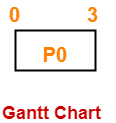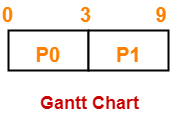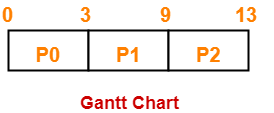HRRN Scheduling-
In HRRN Scheduling,
- Out of all the available processes, CPU is assigned to the process having highest response ratio.
- In case of a tie, it is broken by FCFS Scheduling.
- It operates only in non-preemptive mode.
Calculating Response Ratio-
Response Ratio (RR) for any process is calculated by using the formula-

where-
- W = Waiting time of the process so far
- B = Burst time or Service time of the process
Advantages-
- It performs better than SJF Scheduling.
- It not only favors the shorter jobs but also limits the waiting time of longer jobs.
Disadvantages-
- It can not be implemented practically.
- This is because burst time of the processes can not be known in advance.
PRACTICE PROBLEM BASED ON HRRN SCHEDULING-
Problem-
Consider the set of 5 processes whose arrival time and burst time are given below-
| Process Id | Arrival time | Burst time |
| P0 | 0 | 3 |
| P1 | 2 | 6 |
| P2 | 4 | 4 |
| P3 | 6 | 5 |
| P4 | 8 | 2 |
If the CPU scheduling policy is Highest Response Ratio Next, calculate the average waiting time and average turn around time.
Solution-
Step-01:
- At t = 0, only the process P0 is available in the ready queue.
- So, process P0 executes till its completion.

Step-02:
- At t = 3, only the process P1 is available in the ready queue.
- So, process P1 executes till its completion.

Step-03:
- At t = 9, the processes P2, P3 and P4 are available in the ready queue.
- The process having the highest response ratio will be executed next.
The response ratio are-
- Response Ratio for process P2 = [(9-4) + 4] / 4 = 9 / 4 = 2.25
- Response Ratio for process P3 = [(9-6) + 5] / 5 = 8 / 5 = 1.6
- Response Ratio for process P4 = [(9-8) + 2] / 2 = 3 / 2 = 1.5
Since process P2 has the highest response ratio, so process P2 executes till completion.

Step-04:
- At t = 13, the processes P3 and P4 are available in the ready queue.
- The process having the highest response ratio will be executed next.
The response ratio are calculated as-
- Response Ratio for process P3 = [(13-6) + 5] / 5 = 12 / 5 = 2.4
- Response Ratio for process P4 = [(13-8) + 2] / 2 = 7 / 2 = 3.5
Since process P4 has the highest response ratio, so process P4 executes till completion.

Step-05:
- At t = 15, only the process P3 is available in the ready queue.
- So, process P3 executes till its completion.

Now, we know-
- Turn Around time = Exit time – Arrival time
- Waiting time = Turn Around time – Burst time
Also read- Various Times of Process
| Process Id | Exit time | Turn Around time | Waiting time |
| P0 | 3 | 3 – 0 = 3 | 3 – 3 = 0 |
| P1 | 9 | 9 – 2 = 7 | 7 – 6 = 1 |
| P2 | 13 | 13 – 4 = 9 | 9 – 4 = 5 |
| P3 | 20 | 20 – 6 = 14 | 14 – 5 = 9 |
| P4 | 15 | 15 – 8 = 7 | 7 – 2 = 5 |
Now,
- Average Turn Around time = (3 + 7 + 9 + 14 + 7) / 5 = 40 / 5 = 8 units
- Average waiting time = (0 + 1 + 5 + 9 + 5) / 5 = 20 / 5 = 4 units
To gain better understanding about HRRN Scheduling,
Next Article- Round Robin Scheduling
Get more notes and other study material of Operating System.
Watch video lectures by visiting our YouTube channel LearnVidFun.

